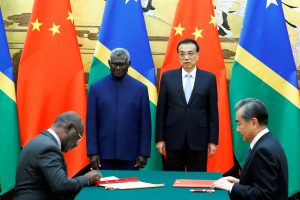With China’s aggressiveness on the rise, the Quad summit in Tokyo should focus on strengthening cooperation in areas such as maritime domain awareness, space situational capabilities, intelligence sharing, and making common use of patrolling and coast guard capabilities, says Amb. (Rtd) Anil Wadhwa
By Anil Wadhwa

Even as the war In Ukraine rages on, regional stability in the Indo-Pacific region continues to be challenged by an aggressive China. China’s military expenditure has doubled from 2009-20. It has embarked on the development of a large number of long-range continental missiles, expanded its long-range bomber force, and undertaken an explosive growth of its blue water navy. In the South China Sea, China has been claiming, militarizing and populating disputed islands on the basis of historical claims and adopting grey zone military tactics like using fishing militias.
China Challenge
Taiwan continues to be under intense pressure and there is an unprecedented escalation in incursions into its Air Defense Zone. Australia has faced sustained Chinese trade retaliation and Chinese naval activity off its coastline. Chinese naval incursions off the Japanese Senkaku islands have increased exponentially. Asean has been struggling for 20 years to lock China into a Code of Conduct (COC).

In the South Pacific, China wants to establish a military presence in the region, gain access to natural resources such as timber, gold, nickel, natural gas, and fish and undermine regional diplomatic support for Taiwan. Following reports of China trying to acquire a base in Vanuatu, and gain a military presence in Papua New Guinea, the security pact with Solomon Islands is an attempt to break out of the second island chain and has come as a shock for the US, and its allies in the region like Australia.
In South Asia, India has faced Chinese aggression on the border since April 2020, which has aggressively been amassing troops all along the undelimited and unsettled border and breaking existing agreements painstakingly put together since 1993. China will continue to seek control not just in Pakistan but in Sri Lanka, Nepal, Bangladesh, by exercising control over public utilities like ports and other infrastructure through opaque loans and financial arrangements. In Pakistan, despite local economic woes and political instability the CPEC rolls on and despite violence and local resistance China’s aim for a thrust into the Persian Gulf and the littoral states of the Indian Ocean, through the port of Gwadar and the adjoining military facility at neighboring Jiwani has continued.
In Myanmar, the Chinese have prevailed upon the ruling junta, which is isolated and shunned by the rest of the world, to revive a number of stalled Chinese projects under the BRI. China’s push into Africa through BRI projects or loans is palpable. In the Middle East and Gulf, more than 60 countries of the region have signed on to the BRI. In most cases BRI projects have an opaque bidding process, and require the use of Chinese firms.
One can expect China to continue its policies in the South and East China Seas, in the Pacific, in the Indian Ocean and in the Indo- Pacific at large. Through a range of strategies like strategic acquisitions, subsidies and funding, theft and forced transfer of technology, mainly from Europe, China has sought to systematically eliminate its dependence on foreign countries for critical technologies and products. Yet, China faces issues like demographic headwinds, Covid related self-inflicted severe lockdowns, and a structural economic slowdown, along with a high-tech denial regime internationally which has emerged as a natural consequence of Chinese policies. There are problems like rising costs of internal security, factionalism in the Party due to Covid mismanagement, debt, demographics, environmental stress and discontent.
AUKUS Factor
The other development of substance and significance is the AUKUS grouping between UK, US and Australia, a trilateral security cooperation agreement announced on September 15, 2021. Under the agreement the US and UK will help Australia acquire 8 nuclear propulsion technology powered submarines to be built in Australia. In the interim, Australia will receive US and UK nuclear- powered submarines increasing its logistics and sustainment capabilities. The AUKUS announcement also mentioned developing joint capabilities, interoperability and information and technology sharing and picks up on cybersecurity, artificial intelligence, additional undersea capabilities, and quantum communications. Australia will acquire long range strike capabilities for its air force, navy, and army, lending a military balance to the region. As part of this defense agreement, the US, UK, and Australia will also be able to protect the undersea fibre optic cables that provides the military and civilian communication meant for them.
Quad’s Response
Reactions to Chinese aggressive action have manifested in many ways. First, the Quad grouping between India US, Japan and Australia has now graduated to the summit level, and has built upon the initiatives of vaccines, climate change and critical and emerging technologies finalized at their virtual Summit in March 2021. In 2021 itself, it has expanded its activities to a host of new areas like decarbonizing shipping and port operations and employment of clean hydrogen technology, resilient clean energy supply chains, critical and emerging technologies like 5G networks, cybersecurity, supply chain of critical technologies and materials including semiconductors, advanced communications and artificial intelligence.
In space, the grouping has decided on ‘responding to challenges in shared domains” which will lead to information sharing on maritime domain awareness. All these steps will challenge the Chinese domination in these fields. The Malabar naval exercises, now include Australia, and without militarizing the Quad, the aim of interoperability of the Quad nations is being achieved and refined with each version of these exercises.
The new Quad grouping between United States, India, Israel and the UAE will focus on connectivity and infrastructure as well as innovation in the region. The G-7 Blue Dot initiative the B3W proposal put forward by USA at the last G 20 Summit, and the EU Global gateway initiative, put forward in September 2021, are designed to challenge Chinese dominance in global infrastructure to counter the BRI. However, these initiatives will need to focus more on readily available finance and less on standards setting if they have to be seen as an alternative to the Chinese BRI in the region.
IPEF Initiative
The US and other countries in the region like Japan have been working on details of the Indo Pacific Economic Framework (IPEF) which will again need to strike a balance between inclusivity and high standards. The plan will be unveiled during President Biden’s visit to Japan in May for the Quad Summit, which will be an important vehicle for its implementation. IPEF is viewed as reflecting the US view to expand ties with key regional economies by building a supply chain which does not depend on China. The focus of the IPEF is expected to be on seven aspects: trade, particularly for small and medium enterprises, standards for digital economy and technology, supply chain resilience, decarbonization and clean energy, infrastructure, workers standards, and other reas of shared interest. Countries can pick and choose their areas of interest. The last Quad Summit had also come up with an initiative on infrastructure based on principles of transparency and accountability standards and focusing on climate sustainability. The EUs Indo Pacific Strategy presented in September 2021, is designed to foster a rules-based order, a level playing field, an open and fair environment for trade and investment tackling climate change and promoting connectivity. While all these are lofty aims, the reality of the Indo Pacific has moved on and the attempts by China to dominate are palpable. In this context, the French Indo-Pacific Strategy, for instance, is more oriented towards hard security, and it seems to better coordinate with partners in the region and the United States.
Outreach to ASEAN
The Biden administration’s attempt to reach out to the Asean through a Summit in Washington in May 2022 puts Asean’s centrality in focus, but the investment of $102 million announced last year or $150 million announced at the May Summit seems small, compared to China’s $1.5 billion aid pledge to Asean and the United States own $ 40 billion in aid to Ukraine. Nevertheless, over time, these initiatives are bound to challenge the Chinese BRI.
The Chinese have reacted to this pushback. On April 21, 2022, Xi Jinping put forward a new Global Security Initiative, which seems to be the political counterpart to the Global Development Initiative he had announced at the UN on September 21, 2021. China could be bothered about the world being divided into democracies and autocracies, and there seems to be a disquiet in China over economic sanctions to cripple adversaries which has emerged as a powerful weapon after the Ukraine crisis. China finds itself on the defensive, as opposed to the triumphalist tone one could discern in its earlier pronouncements, when it used to talk about a declining US, a divided Europe, and an apprehensive Asia. Even the BRI is being couched now in “Green” terms.
However, the Asean is still worried that the Quad may marginalize its centrality and its relevance. In its Indo-Pacific Strategy released in February 2022, the US’ announcement that the Quad will work with Asean has brought home the reality to the Asean that the US approach will be a Quad plus architecture in the Indo Pacific rather than and ‘Asean plus” framework. Even though the Asean has itself to blame for this state of affairs due to the role of Laos and Cambodia in particular, who do not fail to block consensus in the grouping nowadays due to their Chinese dependency, the onus will be on the Quad to take the Asean along through concrete programmes. It is in this context that the Quad Summit in Tokyo on May 24 assumes importance. The Ukraine shadow will loom large, and on this subject, at the very least, the Quad will underscore respect for sovereignty and territorial integrity of all nations in the light of Russia’s actions in Ukraine and once again uphold the Quad’s resolve to meet the challenges of the maritime rules-based order in the East and South China Seas.
The Quad has evolved quickly, united against the clear and present threat from an aggressive China which has broken international law with impunity and has added a number of working groups on supply chains resilience, regional infrastructure, STEM research and innovation, humanitarian assistance and disaster relief, clean energy, maritime security, cybersecurity, counterterrorism, and space in its agenda. Its ambitious public health initiative will combine US technology, Japanese financing, Indian production capacity, and Australian logistics strength to provide Covid 19 vaccines across the Indo Pacific.
In September 2021, the intelligence officials of the four countries took part in a Quadrilateral Strategic Intelligence Forum, and senior Cyber Security coordinators convened in Australia in early 2022. The bilateral agreements between the Quad countries in recent times – the reciprocal access agreement between Japan and Australia, the Australia India ECTA (a trade agreement) and the AUKUS pact between Australia, UK and USA has reimposed mutual trust. But the Quad has not been able to achieve much by way of concrete action or results. The US National Defense Strategy and the Indo Pacific strategy are ambitious documents, but its defense budget and ship building capacity are meagre in comparison the China.
The Quad cannot turn into a hard-core security alliance, but it can strengthen areas of cooperation like maritime domain awareness, space situational capabilities, intelligence sharing, ship repairs, cross servicing and replenishment at sea, and making common use of patrolling and coast guard capabilities. Above all, the Quad must embark of some pilot projects in connectivity and infrastructure building beside the vaccine roll out in the region, in order to be seen as a development partner and an alternate source of financing projects. In this endeavor, it could do well to identify European partners who have developed their own Indo-Pacific strategy, and are keen to work with likeminded countries or groupings in the region to preserve the rule of law, freedom of navigation, and the sovereignty and territorial integrity of states.

(Anil Wadhwa is a former Secretary (East) in the Ministry of External Affairs, and has served as the Indian Ambassador the Poland, Oman, Thailand and Italy. Currently, he is a Distinguished Fellow with the Vivekananda International Foundation in New Delhi and serves on a number of corporate boards.)
Author Profile






